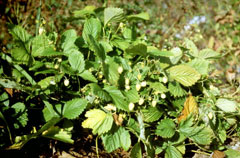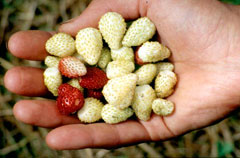 |
|
(c) 2010 Ken Fern & Plants For A Future |
 |
| (c) 2010 Ken Fern & Plants For A Future |
Translate this page:
Summary
Physical Characteristics

 Fragaria vesca 'Semperflorens' is a PERENNIAL growing to 0.3 m (1ft) by 0.3 m (1ft in).
Fragaria vesca 'Semperflorens' is a PERENNIAL growing to 0.3 m (1ft) by 0.3 m (1ft in).
See above for USDA hardiness. It is hardy to UK zone 5 and is not frost tender. It is in flower from May to November, and the seeds ripen from June to November. The species is hermaphrodite (has both male and female organs) and is pollinated by Bees, flies, Lepidoptera (Moths & Butterflies).
Suitable for: light (sandy), medium (loamy) and heavy (clay) soils, prefers well-drained soil and can grow in heavy clay soil. Suitable pH: mildly acid, neutral and basic (mildly alkaline) soils and can grow in very alkaline soils.
It can grow in semi-shade (light woodland) or no shade. It prefers moist soil.
UK Hardiness Map
US Hardiness Map
Synonyms
F. alpina.
Plant Habitats
Woodland Garden Sunny Edge; Dappled Shade; Cultivated Beds;
Edible Uses
Edible Parts: Fruit Leaves
Edible Uses: Coffee Tea
Fruit - raw, cooked or made into preserves[183]. Sweet and succulent with an exquisite taste, they are far superior to the cultivated strawberry[K]. The fruit is fairly small, up to 15mm in diameter, but it is produced abundantly from early summer until the frosts of autumn[K]. Young leaves - raw or cooked[52, 105]. Added to salads or used as a potherb[183]. The fresh or dried leaves are used as a tea substitute[7, 177, 183]. The root has been used as a coffee substitute in India[240].
References More on Edible Uses
Medicinal Uses
Plants For A Future can not take any responsibility for any adverse effects from the use of plants. Always seek advice from a professional before using a plant medicinally.
Astringent Diuretic Laxative Tonic
The leaves and the fruit are astringent, diuretic, laxative and tonic[4, 9, 222]. The leaves are mainly used, though the fruits are an excellent food to take when feverish and are also effective in treating rheumatic gout[4]. A slice of strawberry is also excellent when applied externally to sunburnt skin[4]. A tea made from the leaves is a blood tonic[222]. It is used in the treatment of chilblains[53] and also as an external wash on sunburn[222]. The leaves are harvested in the summer and dried for later use[238]. The fruits contain salicylic acid and are beneficial in the treatment of liver and kidney complaints, as well as in the treatment of rheumatism and gout[244]. The roots are astringent and diuretic[4, 222]. A decoction is used internally in the treatment of diarrhoea and chronic dysentery[4, 244]. Externally it is used to treat chilblains and as a throat gargle[244]. The roots are harvested in the autumn and dried for later use[238].
References More on Medicinal Uses
The Bookshop: Edible Plant Books
Our Latest books on Perennial Plants For Food Forests and Permaculture Gardens in paperback or digital formats.

Edible Tropical Plants
Food Forest Plants for Hotter Conditions: 250+ Plants For Tropical Food Forests & Permaculture Gardens.
More

Edible Temperate Plants
Plants for Your Food Forest: 500 Plants for Temperate Food Forests & Permaculture Gardens.
More

More Books
PFAF have eight books available in paperback and digital formats. Browse the shop for more information.
Shop Now
Other Uses
Compost Teeth
The flowers are an alternative ingredient of 'Quick Return' herbal compost activator[32]. This is a dried and powdered mixture of several herbs that can be added to a compost heap in order to speed up bacterial activity and thus shorten the time needed to make the compost[K]. The fruit is used as a tooth cleaner[4]. The fresh fruit removes stains from teeth if it is allowed to remain for about 5 minutes[4]. The fruit is also used cosmetically in skin-care creams[7]. It tones and whitens the skin, combats wrinkles, lightens freckles, soothes sunburn and whitens the teeth[244].
Special Uses
References More on Other Uses
Cultivation details
Prefers a fertile, well-drained, moisture retentive soil in a sunny position[27, 200]. Tolerates semi-shade though fruit production will be reduced when plants are growing in such a position. Prefers some shade according to some reports[3, 31]. Plants are often found on clay soils[31] and on soils overlying chalk[13]. Alpine strawberries appreciate a mulch of pine or spruce leaves[18]. The alpine strawberry is often cultivated in the garden for its edible fruit. This fruit is fairly small but exquisitely flavoured and is freely produced from June to November. There are some named varieties[183]. It is not very feasible to grow this plant on a commercial scale because it is very labour intensive to pick and it is also hard to get the fruit to market in good quality. However, it is sometimes grown by specialised growers for the luxury market. The main drawback of growing this plant is that it tends to lose vigour after about 2 - 3 years, partly due to virus diseases and partly because the plant flowers and fruits so freely that it exhausts itself.
References Carbon Farming Information and Carbon Sequestration Information
Temperature Converter
Type a value in the Celsius field to convert the value to Fahrenheit:
Fahrenheit:
The PFAF Bookshop
Plants For A Future have a number of books available in paperback and digital form. Book titles include Edible Plants, Edible Perennials, Edible Trees,Edible Shrubs, Woodland Gardening, and Temperate Food Forest Plants. Our new book is Food Forest Plants For Hotter Conditions (Tropical and Sub-Tropical).
Shop Now
Plant Propagation
Seed - sow early spring in a greenhouse. The seed can take 4 weeks or more to germinate. The seedlings are very small and slow-growing at first, but then grow rapidly. Prick them out into individual pots when they are large enough to handle and plant them out during the summer.
Other Names
If available other names are mentioned here
Native Plant Search
Search over 900 plants ideal for food forests and permaculture gardens. Filter to search native plants to your area. The plants selected are the plants in our book 'Plants For Your Food Forest: 500 Plants for Temperate Food Forests and Permaculture Gardens, as well as plants chosen for our forthcoming related books for Tropical/Hot Wet Climates and Mediterranean/Hot Dry Climates. Native Plant Search
Found In
Countries where the plant has been found are listed here if the information is available
Weed Potential
Right plant wrong place. We are currently updating this section.
Please note that a plant may be invasive in one area but may not in your area so it’s worth checking.
Conservation Status
IUCN Red List of Threatened Plants Status :

Growth: S = slow M = medium F = fast. Soil: L = light (sandy) M = medium H = heavy (clay). pH: A = acid N = neutral B = basic (alkaline). Shade: F = full shade S = semi-shade N = no shade. Moisture: D = dry M = Moist We = wet Wa = water.

Expert comment
Author
L.
Botanical References
200
Links / References
For a list of references used on this page please go here
Readers comment